Archeological sites are just the start of a wild loop in this adventure playground. Here's what to do in Amman, Petra, and Wadi Rum.
Jordan, the Middle Eastern country that’s roughly the size of Maine, is one of the most magical destinations in the world. Despite being enclosed by Syria, Iraq, Lebanon, Saudi Arabia, and Israel, it’s also one of the safest. For food, culture, scenery, and archeology, Jordan can’t be beat. Offering world-class hiking, biking, snorkeling, scuba diving and climbing—all without crowds or industrial tourism hype—it ranks high among the world’s most under-appreciated adventure destinations.
History buffs will appreciate some of the planet’s most significant historic sites here, while leisure travelers can bask in beautiful climates and the warm, clear water of the Red Sea.
Jordan is arguably the cradle of civilization. Archeological evidence of hominids goes back 200,000 years. It’s one of the few places where you see modern culture seamlessly blended with early Islamic ruins. The country’s iconic (and ancient) attractions of Petra, the Dead Sea, and Wadi Rum are no secret—but there’s so much more here to explore.
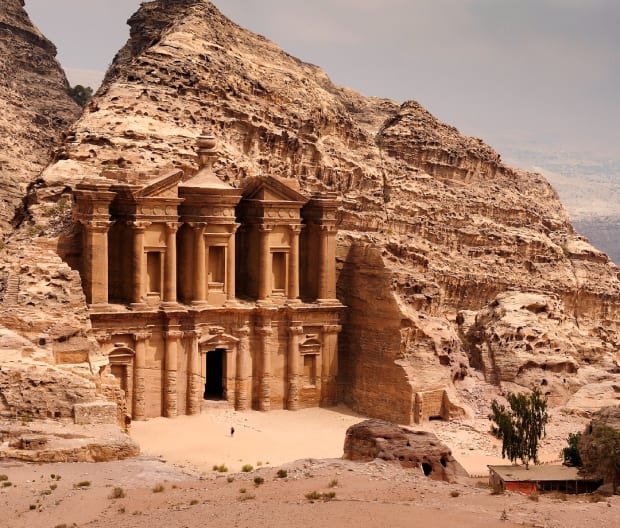
Getty Images/Nick Brundle Photography
Direct flights from the U.S. to Jordan’s capital city of Amman, which recently welcomed a new United flight from Washington DC, take just over 10 hours. You’ll arrive at Queen Alia Airport, conveniently situated midway between Amman and Jordan’s Dead Sea resorts. Once you’re there, getting around Jordan is super easy. While experienced globetrotters may consider renting a car, hiring a knowledgeable and reliable driver often makes good sense for many travelers.
In general, you'll find Jordan to be a relative bargain, filled with affordable five-star hotels and guest houses that are remarkably reasonable. Top farm-to-table restaurants charge a fraction of what you’ll pay in Europe and the U.S. You’ll save even more by visiting during Jordan’s “off season” between November and February.
Link: Tenerife Is an Adventure Hub in Hiding
The only thing that exceeds Jordanian history and culture is its hospitality. Jordanians love welcoming visitors to a world that’s intrinsically exotic and friendly—a kaleidoscope of fragrant spices, tropical plants, vast deserts, and wonderful people. While Arabic is the primary language, English is taught in public schools and commonly spoken. A Muslim nation, Jordan embraces other religions in a country filled with mosques and churches. And while many women choose to cover their hair, arms and legs, it’s not mandatory, except when visiting a mosque.
Standard itineraries in Jordan often stick to tourist favorites like The Dead Sea, Petra, and Wadi Rum, but there’s plenty more to explore if you’re willing to go a bit further off the beaten track. This “loop” takes you from the very modern capital city of Amman, north toward the Syrian border, south to the Saudi Arabian border, then back to the Dead Sea about an hour from the airport. Here’s why it’s time to discover the best of Jordan—and how and where to do it.

Getty Images/Manuel Romaris
What to Do and See in Amman
Amman is a good place to begin your trip as it’s a very walkable city with no shortage of things to see and do. If Jordan is your first Arabic-speaking destination, Amman is the perfect place to start. You’ll rest up from jet lag, get accustomed to the local vibe, and begin to acquaint yourself with the country’s extensive history.
Related: World-Class Cuisine, Spellbinding Souqs, and Aquatic Adventures: The 4-Day Weekend in Aqaba, Jordan
There are a lot of lodging choices in Amman, but the Boulevard Arjaan by Rotana Hotel in downtown Amman is a treat. The new hi-rise hotel, with spacious apartment-style rooms and a rooftop pool, is positioned on a vibrant pedestrian mall with excellent coffee, restaurants, and shopping. There are free concerts on the plaza where you’ll find yourself dancing with people from all nationalities. Have a seat at the hotel bar (yes, most hotels and many guest houses offer alcohol) and enjoy the robust nightlife. Here are some highlights in Amman.
1. Through Local Eyes Tour With Anas Amarneh
The Alternative Downtown Amman Tour is a must for any trip to Amman. Anas Amarneh is the founder of Through Local Eyes, a small company that promotes non-touristy destinations with unique stories. Amarneh’s goal is to help communities benefit from tourism by connecting local landmarks in a highly informative and entertaining walking tour. You’ll stroll through historic neighborhoods and see dozens of colorful murals dedicated to history, politics, music, and art. You’ll visit artist co-ops, non-profit community restaurants, and the Jamal Rima Library—a collaboration between prominent intellectual writer Jamal Abu Hamdan and renowned feminist scholar Rima Eirani.
2. Beit Sitti Cooking Classes
Beit Sitti translates to “my grandmother’s house.” It's a culinary adventure for the traveling epicure, and our vote for the top cooking experience in the country. During this class, run by three highly skilled women, you’ll learn how to make a traditional, three-course Arabic meal in one of the oldest neighborhoods in Amman. You’ll then dine on your own creation in a charming open-air courtyard and sip local wine—or opt for a bottle of cold Carakale Blond Ale from a local micro-brewery dedicated to creating a beer culture in Jordan.

Getty Images/Walter Bibikow
3. King Abdullah I Mosque
Equally as magnificent as the great cathedrals of Europe, the historic mosques of Jordan deserve time to explore and marvel upon—starting with the King Abdullah I Mosque. The mosque, which took more than eight years to build, features a magnificent blue dome with luminous stained-glass windows and a chandelier. From here, you can walk to the Hashemite Plaza at the base of a Roman theater, replete with gardens, fountains, and people milling around enjoying the scene. Then, take a cab to Rainbow Street, a focal point of Amman’s nightlife, full of coffee houses, restaurants, shops, and clubs where people party into the early hours.
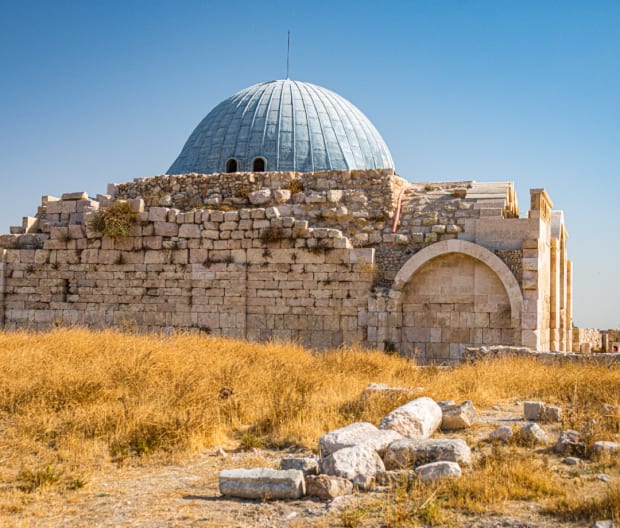
Getty Images/Emad aljumah
4. Citadel Hill
Humans have lived in the ancient quarters of Amman since the 8th century B.C. Citadel Hill is a huge archeological park that provides a glimpse into the region’s rich history. There’s a 1,700-meter wall from the Bronze Age, the Temple of Hercules, a 6th-century Byzantine church, and Ain Ghazal Statues that date back thousands of years. For reflection on more modern history and art, take a taxi to Darat al Funum. Run by the Khalid Shoman Foundation. This picturesque, historic house and its ancient courtyard are a home for artists who celebrate the region’s history and scenery.
Link: Why Safari-goers Are Adding Mozambique to the Itinerary

Getty Images/Mohammad Arar
What to Do and See in Northern Jordan
Most travelers head straight from Amman to the Dead Sea, Petra, or Wadi Rum. But the ancient villages north and northwest of Amman are an adventure traveler’s paradise. This region receives fewer tourists (you may well be the only American in a village) and offers family-style guest houses, locally guided hikes, and uncrowded archeological sites. Baraka Destinations partners with local communities—including As-Salt, Pella, and Umm Quais—to showcase many off-the-beaten path villages in a sustainable way. You’ll find genuine hospitality, tasty (and healthy) farm-to-table food, and opportunities to not just hike and bike through impressive scenery but visit olive orchards, work with beekeepers, and learn about the region’s rich history and culture.
1. As-Salt
About an hour northwest of Amman, As-Salt (aka Al-Salt or just plain “salt”) served as an important trading stop between the East and West during the Byzantine, Roman, and Mamluk eras. You can visit Roman Tombs, the remains of an Ayyubid fortress, ancient churches, and a fascinating Archeological and Folklore Museum. The open-air market snakes through the village’s narrow streets, packed with vendors selling coffee, spices, perfumes, and hand-made crafts you won't find anywhere else.
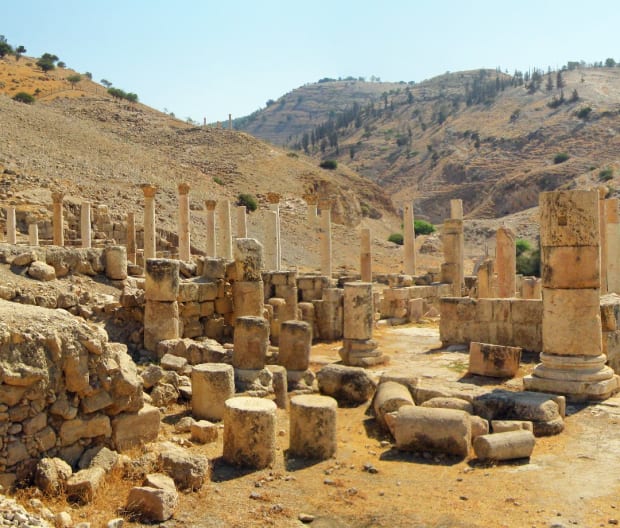
Getty Images/HisWondrousWorks
2. Pella
For jaw-dropping views of one of Jordan’s great historic sites, stay at Beit Al Fannan, a beautiful house built by the famous Jordanian architect and artist, Ammar Khammash. You get the entire house with a full kitchen, dining and living room, sweeping decks, and a cave underneath that’s been turned into a mini studio. The village of Pella has been inhabited for at least 9,000 years. From the Beit Al Fannan house, you can hike to the ruins, which date back to the Stone, Bronze, and Hellenistic ages.

Getty Images/yafa80
3. Umm Qais
Umm Qais, in the northwestern corner of Jordan, sits on the hills above the Jordan River Valley and Sea of Galilee (aka Lake Tiberias) and Syria’s Golan Heights. The village was once known as the Decapolis city of Gadara. The archeological site is huge, with impressive colonnaded streets, a massive vaulted terrace, and two nearly intact theaters. In its Roman heyday, the population exceeded 30,000 and was supplied with water by more than 100 miles of aqueducts and tunnels.
Link: American Ruins—A Look Back at the Nation’s Industrial Heyday
In 2022, the World Tourism Organization named Umm Quais one of the best tourism villages for sustainability and innovative ways to further community and traveler interaction. Umm Quais is also the start of the Jordan Trail, which includes both hiking and mountain biking trails spanning over 675 kilometers, connecting 75 villages across the length of the country.
4. Rasoun Village
Tucked in the forests of northwest Jordan, near the larger town of Ajloun, Rasoun Village is renowned for its scenery and spectacular rock climbing. You’ll want to stay at Eisa Dwekat Guest House, hosted by the first adventure guide in Jordan. It's perched on a hillside with excellent views of the surrounding country. Your guide, Dwekat, will take you hiking on the Jordan Trail (he’s on the board of directors) and show you some excellent limestone sport climbing crags. Back at his home, you’ll enjoy traditional home-cooked Jordanian food.
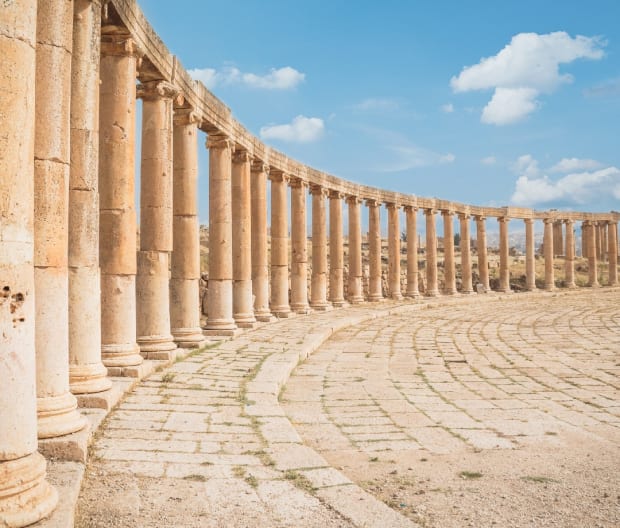
Getty Images/Yuri Nunes:EyeM
5. Jerash
Jerash Archeological Park is not only massive, but also one of the best-preserved Roman ruin sites outside of Italy. Perched on a hillside in the city of Jerash, the Archeological Park offers stellar views across the city and the old Roman Baths, but there’s more to Jerash than ruins and nice vistas. It’s also the scene of a thriving foodie culture. After visiting the Archeological Park, head to Beit Khairat Souf where you’ll be treated to a delicious traditional Jordanian meal in a comparatively “modern” building dating back a mere 140 years.

Getty Images/Ramon Coloma Mozos
Unique Experiences You Can't Miss in Jordan
1. Taking the Back Door to Petra
The magnificent UNESCO archeological site of Petra is Jordan’s most-visited site. Its huge tombs and temples were carved into the sandstone cliffs by the Nabateans around 300 B.C. Most visitors enter through the main entrance, Al Siq, and a nearly 200-foot-long cleft in the canyon wall—but the best way to enter Petra is through “Little Petra.” This backdoor into the archeological site involves a 10-mile hike on a path that winds through hills and canyons. You end up at “The Monastery,” one of Petra’s most famous monuments. The key to visiting Petra is taking the time to hike around as there are 2,640 acres to explore—so plan on at least three days. Stay at the Hayat Zaman Hotel, a re-purposed 19th-century village with individual bungalows and 5-star accommodations.
2. Climb and Hike Around Wadi Rum
There’s a reason dozens of films use Wadi Rum as a set location. The dramatic landscape with its castellated cliffs, natural arches, caves, and giant sandstone domes rising high above the desert is otherworldly. The Wadi Rum protected area, a 300-square-mile preserve, is four hours south of Amman and less than an hour north of the Red Sea port/resort town of Aqaba. Wadi Rum is home to many of Jordan’s Bedouin population, who’ll welcome you with tea and, most likely, music. You can stay in the small village of Rum or sleep in a “Bedouin Camp” in small cabana-style tents. An international rock-climbing destination, the area offers remarkable hiking as well. Highly trained Bedouin guides will be able to show you both technical climbs and traditional Bedouin routes.

Yazan Alsaad
3. Dive in Aqaba
Aqaba is a world-class diving and snorkeling destination sitting on the southernmost point of Jordan on the Gulf of Aqaba at the tip of the Red Sea. Spend a day (or several) here with Sea Guard. Whether you dive, snorkel, or simply enjoy sitting on a deck with a cool drink and delicious grilled food, dive captain Yazan Alsaad and his family will show you Jordan’s coastline and introduce you to its abundant sea-life and rich coral reefs.
The scuba views here are teeming with colorful fish and sea turtles, and the currents are generally calm and snorkeler-friendly. Technical divers will want to explore several excellent underwater wrecks—including a Lebanese freighter, a C-130 Hercules plane, a large crane barge, and an M42 “duster” anti-aircraft vehicle—all sunk by the Jordanian Royal Ecological Diving Society to help build and preserve reefs. Aqaba also has a robust nightlife, excellent shopping, and unsurprisingly some of the world’s best seafood. Stay at the 5-star Kempinski Aqaba Red Sea, featuring spectacular Red Sea sunsets from every room and a delightful poolside bar.
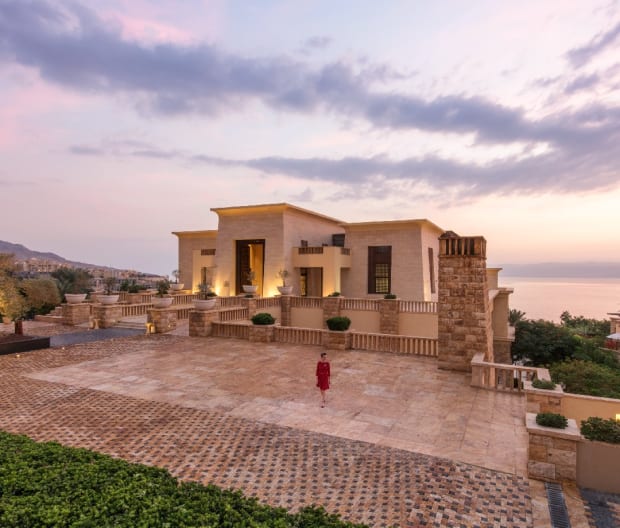
Courtesy Image
4. Soak in the Dead Sea
A stop at the world-famous Dead Sea is naturally on everyone’s itinerary here—the perfect spot to cap off an incredible journey through Jordan. There are several great hotels, but Kempinski Ishtar, with its excellent spa is truly spectacular, occupying a private cove where you’ll find pots of therapeutic mud to coat yourself with before floating in the highly buoyant salt water. While here, don’t miss a day trip to Ma ‘in Thermal Springs and some idyllic canyoneering through the waterfalls of Wadi Mujib Biosphere.
from Men's Journal https://ift.tt/uk5OvAl
No comments:
Post a Comment